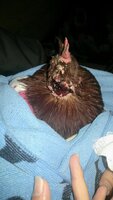I think we are all typing at once!@Wyorp Rock beat me to this by just a few minutes, but it doesn't hurt to hear it from both of us.
Good advice as always Carol!
↓↓↓↓↓↓
I'm in agreement with @sylviethecochin that a crop issue would be the number one suspect. Other clues are the array of fresh produce your hen eats, and the other clue is that she's confined indoors. The last clue is her poop. It shows no food is likely being processed by her body.
You say the hen has access to grit and calcium. Would that be oyster shell? Is that what you are providing as grit? Even if she has proper grit, it's still possible to get impacted crop after eating too much fiber. The way to verify a crop disorder is to check her crop in the morning again before she has anything to eat or drink. If, as I suspect, her crop is still full and firm, you will need to treat her for impacted crop. If her crop is full, but soft and spongy, you'll need to treat for sour crop. An anti-yeast medicine is necessary for this. (Miconazole or Nystatin)
I like to use coconut oil since it's easy and safe to administer with very little danger of aspirating the oil. Very serious impacted crops can take an entire day to clear if this is her issue. I recommend a teaspoon of oil at a time with very gentle massage for five minutes. Wait an hour and repeat.
Do this as many times during the day as necessary to break up the mass and you feel it go down. After three sessions of oil and massage, if the crop isn't budging, then I administer a capsule of a non-stimulant stool softener, one more teaspoon of oil, let it work for half an hour, then massage the crop.
It's very, very important that after the crop clears, the hen is provided with granite grit for adult chickens. While oyster shell seems solid, it's water soluble and won't work as grit if that's all she's been getting. Granite grit is found at all feed stores and it has the properties necessary to grind up food in the gizzard. (Think sharp garbage disposal blades.)
Along with granite grit, offer yogurt and/or boiled egg and plenty of fresh water until she gets her appetite back.
As an aside, calcium and grit consumption varies from chicken to chicken according to their individual needs. Therefore, it's a wise practice to offer these two things free choice so the individual can regulate their intake to satisfy their own individual needs.
The best way to do this is to have a special small container for grit and another for oyster shell (instead of powdered or liquid calcium). Mixed into the food, there's a risk the chicken will get either too much or too little, which can end up causing problems. Too much grit can cause impacted gizzard. Too much calcium and cause kidney damage.




 IF, IF the crop clears, then offer her a little wet feed.
IF, IF the crop clears, then offer her a little wet feed.
